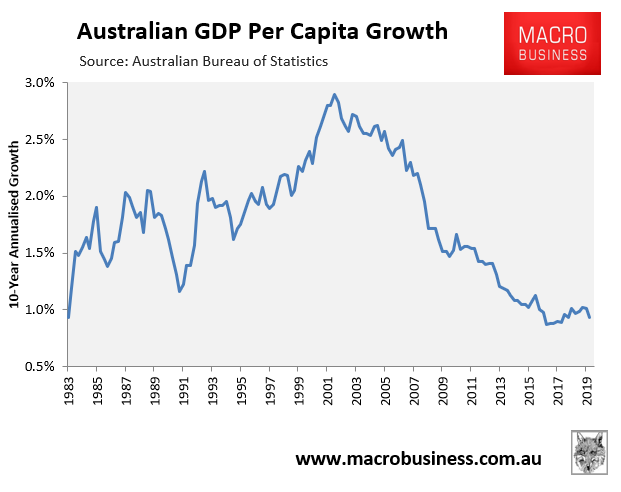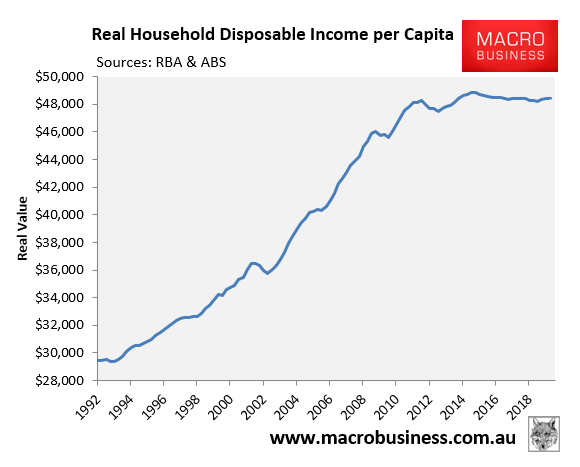I’ve had a bunch of email complaints this morning from very reasonable people about last night’s 7.30 Report immigration hogwash:
There could be a million fewer people than previously predicted in Australia by the end of the decade as a result of COVID-19, producing an annual hit to the economy of $117 billion by 2030 and an ageing workforce.
The forecasts, from consultancy KPMG, highlight some of the longer-term impacts of the global pandemic on an Australian economy which has relied on a continued boom in population — mostly from migration — for growth in recent years.
Even if a vaccine is found within 12 months, according to KPMG, the shortfall in previously forecast population would be around 420,000 by 2030. But if there is no vaccine for at least two years, it would be 1 million people.
The forecasts raise the question of how the country best rebuilds its migration program post-pandemic, at a time when there are already political pressures to limit migration in future if unemployment is already high.
KPMG says that in the absence of a vaccine in the next two years, Australia’s population in 10 years is projected to be 28 million rather than the 29 million predicted by the Australian Bureau of Statistics before the COVID-19 crisis.
The $117 billion loss of GDP, on an ongoing basis, equates to an $80 billion drop in household disposable income — or $2,800 a person.
“What net overseas migration does is it gives us a demographic dividend,” KPMG chief economist Dr Brendan Rynne told 7.30.
“That enables us to reinvigorate our population with younger people into our workforce”.
We all know that the ABC is racist these days in the sense that it judges everything in terms of ethnicity uber alles. So it’s obviously vulnerable to this kind of immigration rent-seeking that we see repeatedly from corporate hacks.
So, for the benefit of the racist kiddies at the national broadcaster let’s unpack this a little.
There is no one way to grow an economy. But different ways of doing so means the benefits flow to different economic segments.
The traditional method of growing an economy is the use of economic reform to drive productivity growth which boosts profits that are shared with workers in the form of higher wages. They can then spend more and consumption rises which feeds back into more profits and investment, so on and so forth. This model of development keeps an economy competitive for exports and import-competers to grow as well. With sensible policy, it also shares the benefits equally between households and businesses. Eventually, these kinds of cycles can overheat, you get capital misallocation and inflation, and the central bank steps on it resulting in recession, creative destruction, a debt cleanout and the cycle begins again.
Over the past few cycles, the rise of rent-seeking in place of reform introduced a new growth model to Australia.
It began with the rise of China, an external boom that created supply-side shortages for many commodities, and lifted demand for Australian workers to unusually high levels given we have a lot of the commodities that were in short supply. To prevent an inflation blowout owing to labour shortages the Howard Government lifted immigration rates. So far, so good.
But the external boom ended in 2011. When it did, rather than let a healthy recession cleanse the excesses of the cycle from the system, Aussie macro managers decided to change the growth model. They did this by keeping the immigration gates wide open even as demand for labour collapsed. This had two effects.
First, it crush-loaded every public service in sight, lowering living standards. This created some new public and housing investment but nowhere enough to fill the growth hole emanating from the collapsing external boom.
Second, with so much spare labour capacity pouring out of the collapsing external boom, and so much cheap foreign labour pouring in through the border, wages growth crashed. Especially so as immigration-led wage theft become standard business practice under a worker-hating Coalition Government.
Sure, this growth model eventually created more demand for such businesses such as housing, banking and retail simply by adding more warm bodies. But all of the benefits of that growth now accrued ONLY TO THESE INTERESTS. This meant that aggregate demand plus growth remained weak. Productivity was crushed. And all per capita measures of the Australian living standards stalled out. Per capita GDP growth collapsed:

As did real per capita household disposable income growth:

In short, driving mass immigration into an economy that was already full of slack devastated workers for a decade. Yes, in aggregate, this “trickle-down” model delivered growth, but only to the few and virtually none in per capita terms, as everybody else got to lie in the wet spot of falling living standards.
This is the most vital point to make today. After COVID-19, we now have the highest levels of under and unemployment since the Great Depression. Adding mass immigration to this mix will crater wages must faster than the last cycle. Governments will not invest enough to fill infrastructure shortages and living standards will fall much faster as well.
I won’t gild the lily. Growth and unemployment will be difficult for a while without immigration as well. But it will come as competitiveness lifts, governments invest to fill the infrastructure deficit from the last cycle and other reforms, and we are forced to go back into the more traditional growth model that shares economic benefits.
So, I ask you, ABC racists, is your paranoia about one fire-haired biggot from QLD really worth remaining the useful idiot of a narrow band of greedy capitalist pigs that were, and are still, taking the overwhelming majority of Australians for a ride? So much so, that another cycle of this model and Australia will resemble the catastrophic inequalities of the US class structure. KPMG is an apologist for the notorious 1% fat cats that sits atop that steaming economic pile.
The next time one of these greedy bastards comes knocking, the ABC should take the opportunity to not impose racist dogma on ordinary Australians and instead think through who it is really working for.

